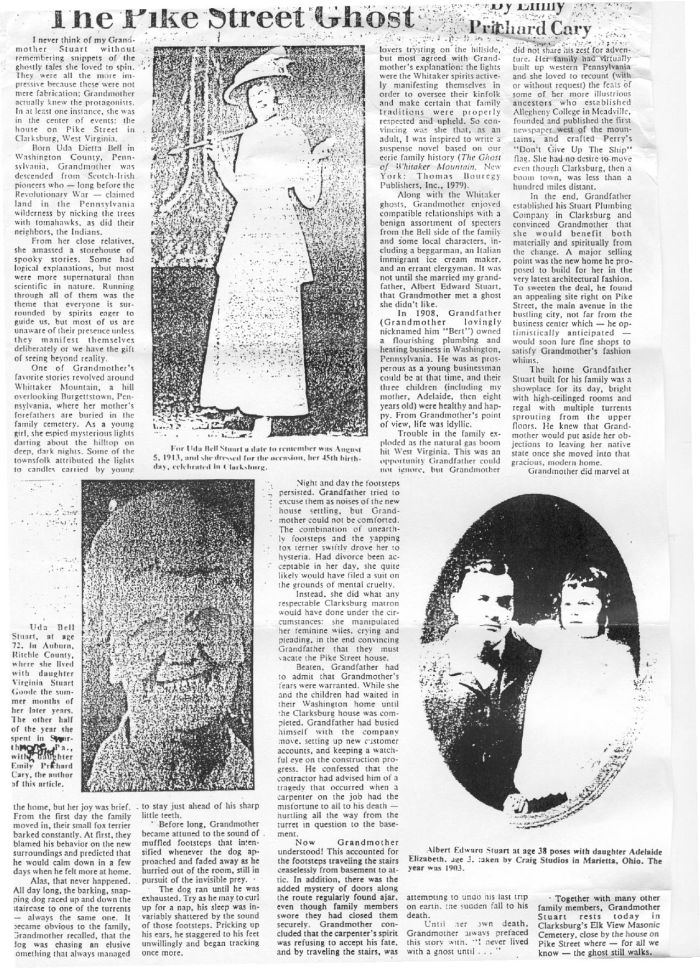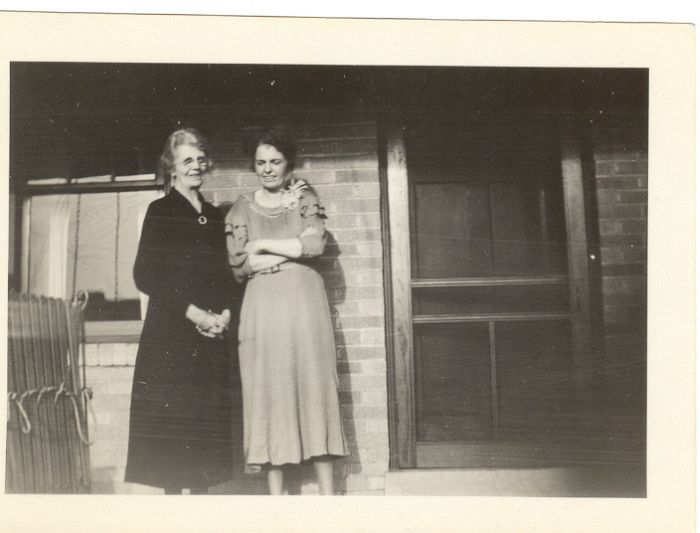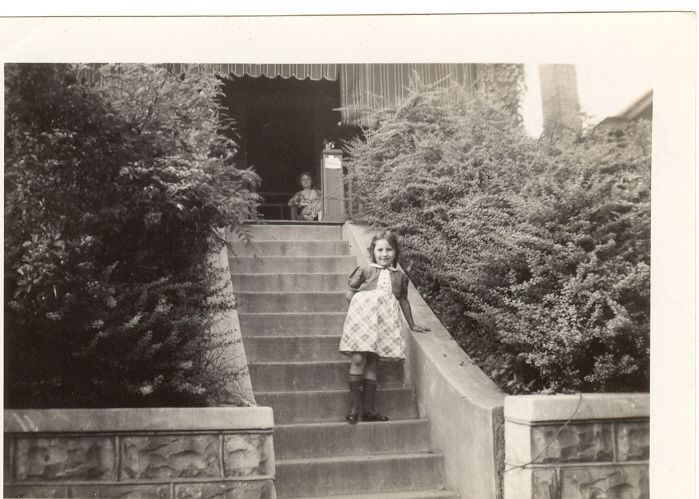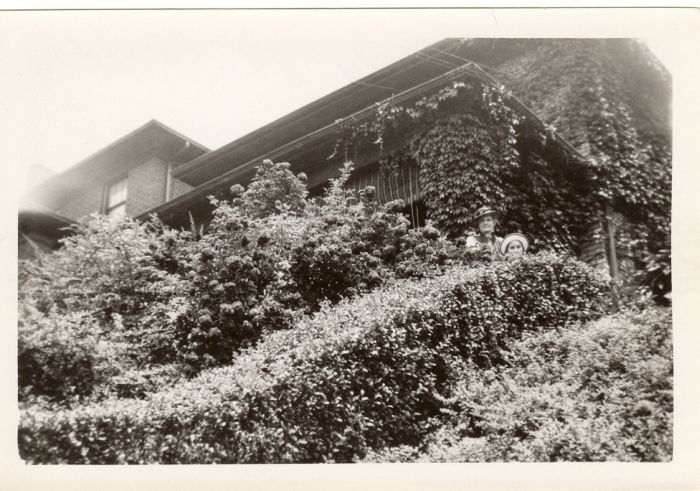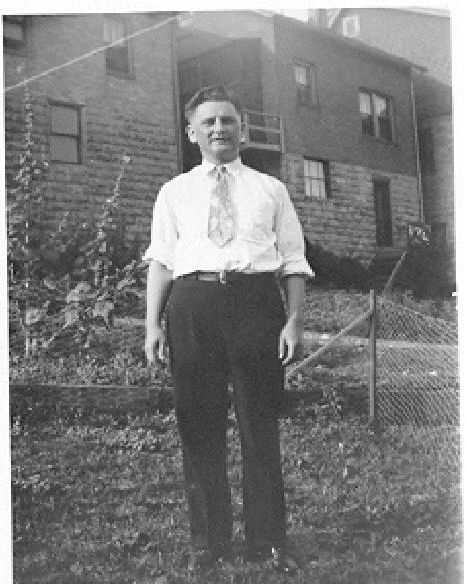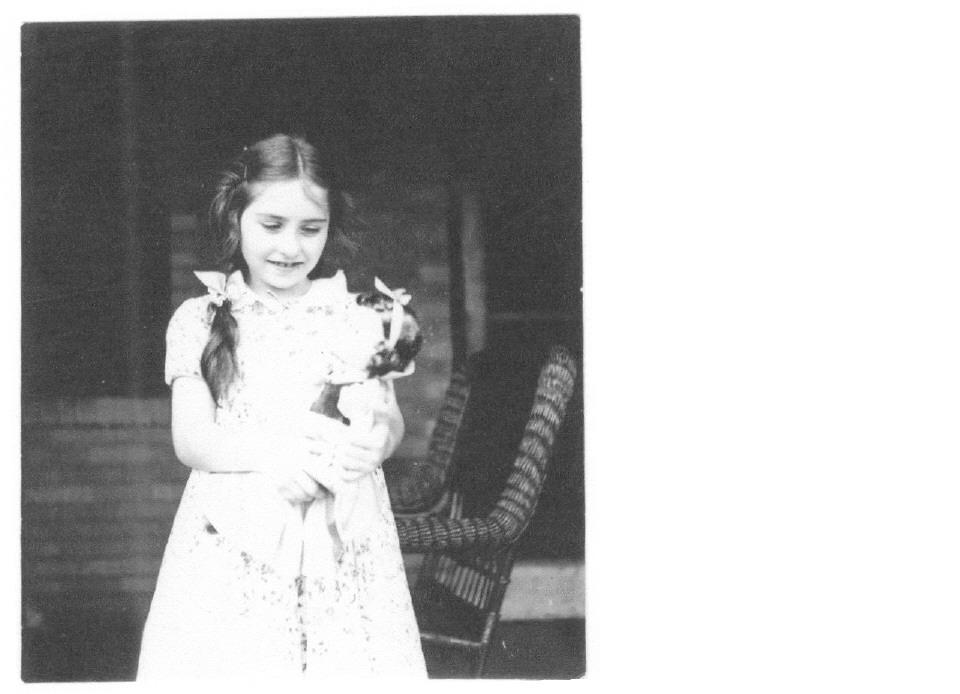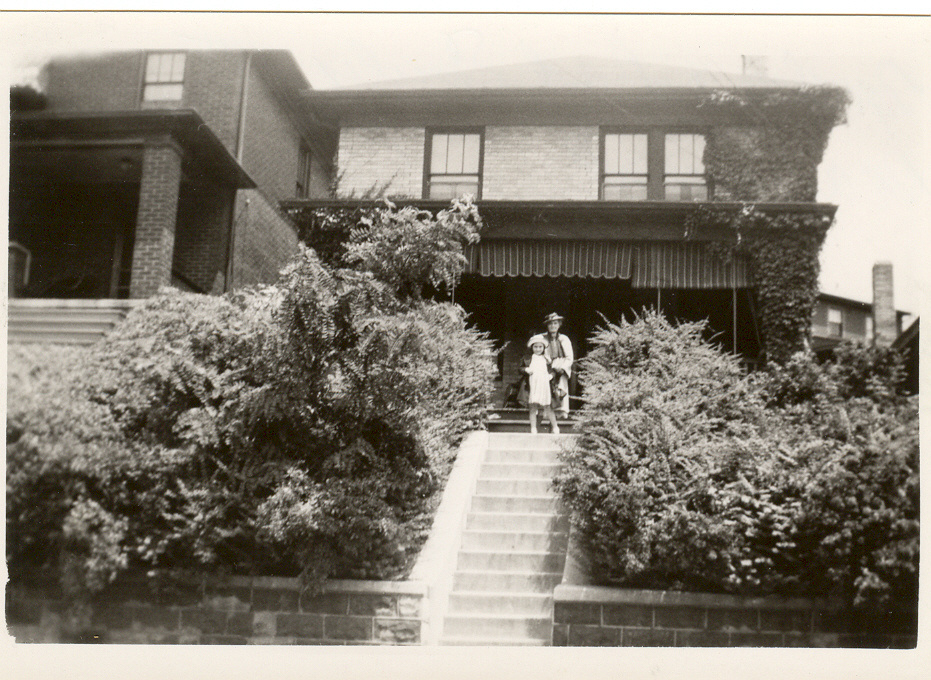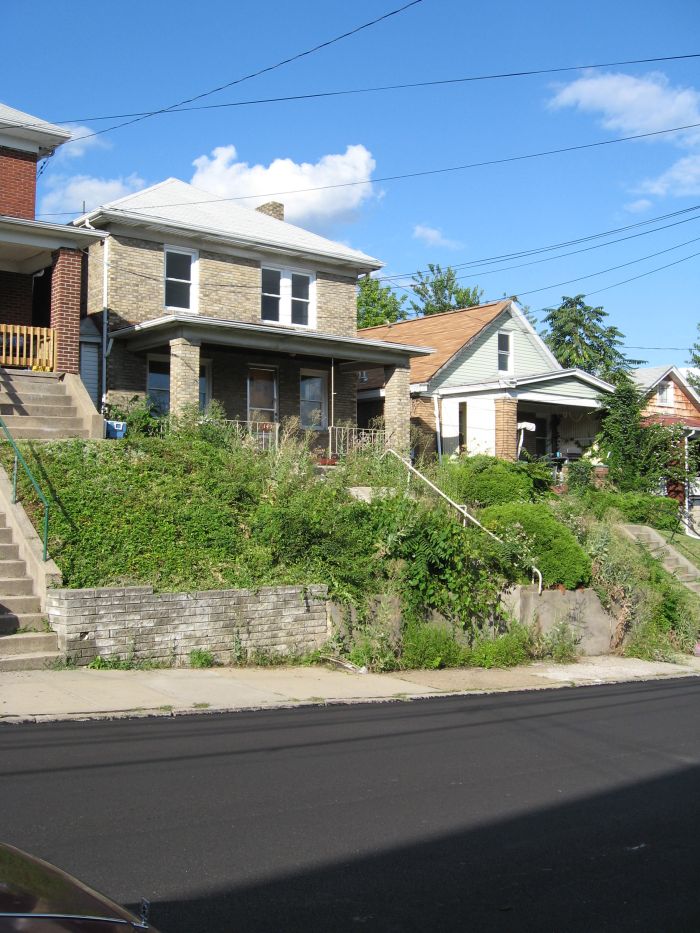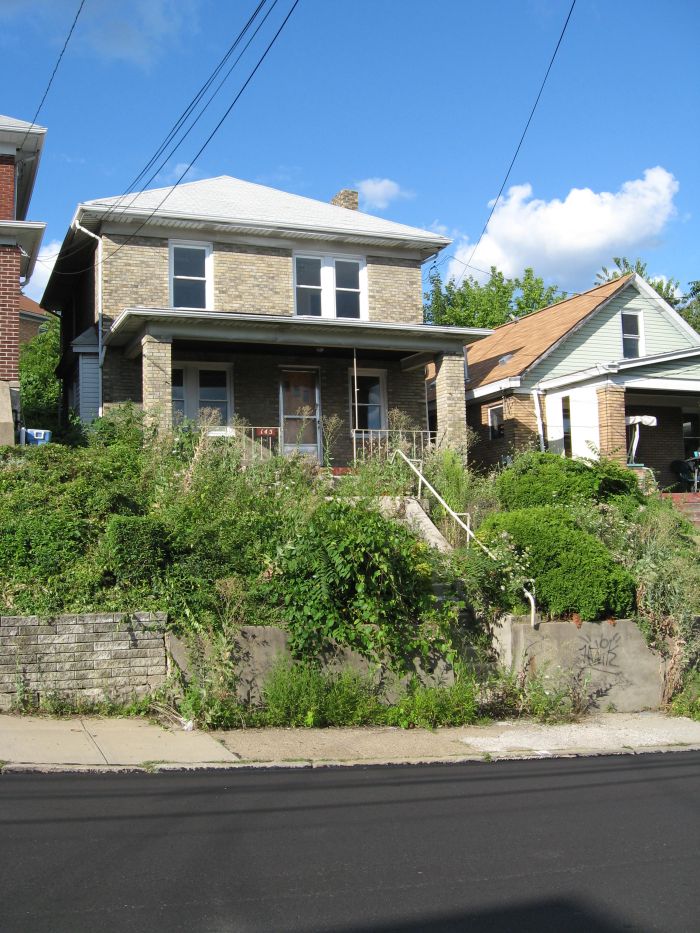Emily Prichard Cary
Contents
- 1 Emily Pritchard Cary wrote the story under the subject Depression Life in the Carrick Glossary of Terms.[http://www.post-gazette.com/pg/08222/902960-109.stm?cmpid=HBEHTML as appears in the Post-Gazette.]
- 2 Emily Prichard Cary's story about a Brownie in the house at 145 Madeline Street
- 3 1933 Madeline is of my grandmother, Uda Bell Stuart, and my mother, Adelaide Stuart Pritchard standing at the front door.
- 4 The Madeline staircase is of me halfway down to the bottom (being watched very carefully by my grandmother on the porch in case kidnappers happen by).
- 5 The Madeline bushes shot was taken of Mother and me one Easter Sunday in our finery peering over the bushes. I can't get over all the greenery. It looks as if the house is bathed in vines.
- 6 This is my father, Ernest Pritchard, standing in front of the hollyhocks in our backyard. To his left (out of the picture) is our one-car garage. My mother learned to drive coming down the steep alley and making K-turns into the garage. The houses behind him are on Scout Street. I believe that the one on the left was occupied by the Lowe family. The one to its right by the Haas family. (Their daughter, Valerie, had diabetes, very rare for children in those days. Today about half of the children in every Phoenix classroom has it.)
- 7 Incidentally, the photo sent previously of my father in the backyard does not show the Steck house on the corner of Scout and the alley. Jim Steck worked for AT&T, but was laid off (the only one so tapped in my father's group). My parents were so embarrassed that Father went to the boss and offered to take Jim's place, but was told that they had been looking for a way to get rid of him and nothing anyone could do would make them change their minds. Within a few months, Jim Steck was hired as an on-air announcer at one of the Pittsburgh radio stations and prospered far better than his former co-workers. They soon bought a very fancy house in Brentwood. Only after confirming the entire family died did I dare write about his wife, whom my grandmother feared would go to the devil because she smoked and wore slacks, and their erramt child, Bunky, who strangled cats, damaged everything in the neighborhood he touched, and ended up dying in a California prison.
- 8 I just found this copy of the prize photo taken by Harry Lynch. My grandmother became deaf following the 1919 flu epidemic as did Harry, the son of her friend. He attended the Deaf School in Pittsburgh majoring in photography and every year or so would come around to take our pictures. He spent hours posing us in every conceivable situation and always stayed long enough to partake of a hearty meal. On this occasion, I was exhausted from riding my tricyle, swinging on the swing, playing jacks, and doing whatever else he asked of me. When I burst into tears and picked up my Snow White doll (which I'd earned by not crying when Dr. Askins - office on Brownsville Road - lanced my ear for the seventh time), he took the final picture. Incredibly, it won first prize in a city-wide contest.
- 9 Here are two views of 145 Madeline street. The Strouds lived to our right (red brick) and the Richters to our left. They had come from Germany after WWI. During WWII, the Strouds told us that the Richters were accused of being Nazi sympathizers, even though they weren't. Their son, Fritz, taught in a Pittsburgh high school. When I study the 1930 census, I see that many of the people living on or near Madeline Street had come from Germany. My mother loved being near them because they were so clean and the food they shared was delicious.
- 10 145 Madeline Street, 8/15/08
- 11 145 Madeline Street, 8/15/08
Emily Pritchard Cary wrote the story under the subject Depression Life in the Carrick Glossary of Terms.[http://www.post-gazette.com/pg/08222/902960-109.stm?cmpid=HBEHTML as appears in the Post-Gazette.]
Emily Prichard Cary's story about a Brownie in the house at 145 Madeline Street
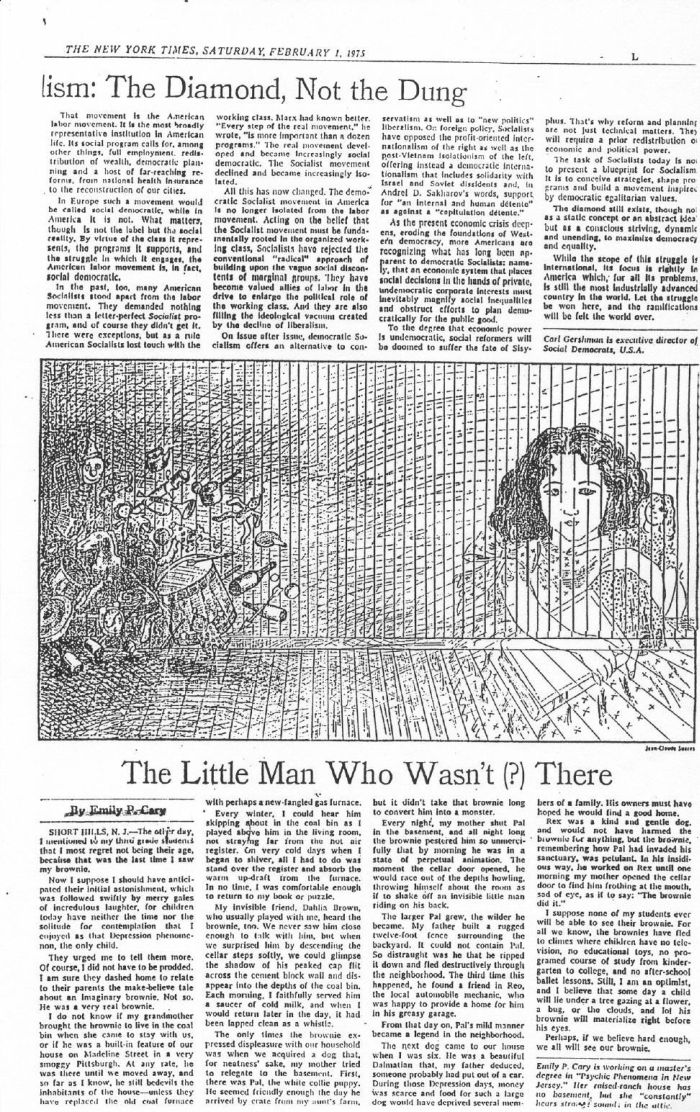
Our dogs did go crazy; however, my father later believed that Rex, the Dalmatian, developed distemper from sleeping in the cold before we took him in. We had him for the better part of a year, so who knows what transpired. Pal, the Collie, thrived for years in the garage that was a block or so down the hill from us on the opposite side of the street (next to a steep alley, I recall). Reo, the mechanic who took him in, had a red face and sweat constantly poured down his face and neck. He regularly offered me a "chaw" of his tobacco which I eagerly accepted (until my father snatched it away from me), believing it to be chocolate."
1933 Madeline is of my grandmother, Uda Bell Stuart, and my mother, Adelaide Stuart Pritchard standing at the front door.
The Madeline staircase is of me halfway down to the bottom (being watched very carefully by my grandmother on the porch in case kidnappers happen by).
The Madeline bushes shot was taken of Mother and me one Easter Sunday in our finery peering over the bushes. I can't get over all the greenery. It looks as if the house is bathed in vines.
This is my father, Ernest Pritchard, standing in front of the hollyhocks in our backyard. To his left (out of the picture) is our one-car garage. My mother learned to drive coming down the steep alley and making K-turns into the garage. The houses behind him are on Scout Street. I believe that the one on the left was occupied by the Lowe family. The one to its right by the Haas family. (Their daughter, Valerie, had diabetes, very rare for children in those days. Today about half of the children in every Phoenix classroom has it.)
Incidentally, the photo sent previously of my father in the backyard does not show the Steck house on the corner of Scout and the alley. Jim Steck worked for AT&T, but was laid off (the only one so tapped in my father's group). My parents were so embarrassed that Father went to the boss and offered to take Jim's place, but was told that they had been looking for a way to get rid of him and nothing anyone could do would make them change their minds. Within a few months, Jim Steck was hired as an on-air announcer at one of the Pittsburgh radio stations and prospered far better than his former co-workers. They soon bought a very fancy house in Brentwood. Only after confirming the entire family died did I dare write about his wife, whom my grandmother feared would go to the devil because she smoked and wore slacks, and their erramt child, Bunky, who strangled cats, damaged everything in the neighborhood he touched, and ended up dying in a California prison.
I just found this copy of the prize photo taken by Harry Lynch. My grandmother became deaf following the 1919 flu epidemic as did Harry, the son of her friend. He attended the Deaf School in Pittsburgh majoring in photography and every year or so would come around to take our pictures. He spent hours posing us in every conceivable situation and always stayed long enough to partake of a hearty meal. On this occasion, I was exhausted from riding my tricyle, swinging on the swing, playing jacks, and doing whatever else he asked of me. When I burst into tears and picked up my Snow White doll (which I'd earned by not crying when Dr. Askins - office on Brownsville Road - lanced my ear for the seventh time), he took the final picture. Incredibly, it won first prize in a city-wide contest.
145 Madeline Street, 8/15/08
145 Madeline Street, 8/15/08
From Emily Prichard Cary to John Rudiak on 8-16-08:
"The house at 145 Madeline Street looks to be very much as it was the last I saw it about 30 years ago. I'm sure much of the credit goes to the sturdy brick construction typical of pre-war Pittsburgh. I see that the shrubbery is overgrown today, as it was when we were there. I remember being scratched daily by the barberry bushes.
I'm pleased that you like the piece appearing in the Post-Gazette. Over the years, I've written quite a bit about growing up in Pittsburgh during the Depression. The first article published appeared Feb. 1, 1975 on the New York Times Op Ed Page. At the time, a prominent book editor fell in love with it and asked me to write my memoirs, but I was busy teaching and declined for lack of time. When I finally got around to tackling the project, she had died. Which only goes to show my grandmother was right about striking when the iron is hot. I'll send you a copy of the piece, which I hope is readable. I believe that it can still be accessed on the New York Times archives web site. It reminisces about the house, the coal furnace, and the brownie that my grandmother swore lived in the coal bin to bring us good luck.
My mother was not so certain about the good luck aspect of the place. Just six months after my parents built their dream house on Rolling Hills Road in Baldwin Manor, AT&T transferred my father to the Philadelphia office. It meant leaving all their friends and going to a strange city where Mother was disqualified from teaching (which she had loved doing before their marriage) because of the ban against married women in the classroom. She cried all the way along the Pennsylvania Turnpike to our new home in Swarthmore, a suburb of Philly. Every time I drive that road, I remember that day and wonder how my father was able to concentrate on driving.
We arrived there two months before Pearl Harbor. The next year, Mother had a reprieve. Permitted to teach again and take the place of a drafted male teacher, she thrived once more and continued teaching until just a few months before her death in 1969.
Several of my recent Pittsburgh stories have won first prizes from the Southern California Genealogical Society. One about my ancestor who made the "Don't Give Up The Ship" flag is in an anthology published by Heritage Publishers, which also published three editions of my Pritchard Family History, the latest updated in 2006.
So many of my stories go back to Pittsburgh and my family. One tale my grandmother told about mysterious events in Washington County, Pennsylvania ended up in "The Ghost of Whitaker Mountain." When the book first came out, I was invited to speak at the Carnegie Library in Burgettstown. Although I had planned to visit Carrick that day, there simply wasn't time to catch my plane back to Washington (we lived in Fairfax, Virginia at the time). So I was delighted to receive a request from the English Department at Burgettstown High School to give a writing workshop a year ago last February. My husband and I planned to spend several days in Pittsburgh at that time, but one month before we were scheduled to leave, he had a stroke and heart attack. Although he is pretty much back to normal, we haven't had another opportunity during the interim to visit there. I hope we make it back before U.S. Airways (the only carrier that flies there from Phoenix) goes out of business.
My father, who always enjoyed taking long walks around Carrick, was pleased to discover that one of our new neighbors in Swarthmore was Jim Hornaday, the son (or perhaps grandson) of William T. Hornaday. Jim Hornaday, Jr. was a year ahead of me in Swarthmore High School. My father and Mr. Hornaday walked to the train station every day and frequently reminisced about Pittsburgh.
Not long ago, I found a photo of the old Concord School (circa late 1800s) on a Pittsburgh web site. That is where I first started school. Unfortunately, the principal insisted that I enter second grade at age 5, having learned to read at two. My parents were thrilled, but it took me years to catch up in math and phys ed. My penmanship is illegible to this day (never could master those Zaner-Blozer ovals) and I was the only one in my classes throughout school who couldn't do a cartwheel. Such are the disadvantages of being pushed academically.
I have so many stories about Pittsburgh during the Depression that I'd love to combine them all in a book one day. Some are sad, like the death of a classmate from the flu during the floods; others are exciting, like my Mother's discovery of a player piano for $7 (with free delivery) at a music store in Mount Oliver; still others are funny, like the deaf mute (son of my grandmother's friend)who visited our house regularly and won first prize for a photo he took of me with my Snow White doll after posing me for more than an hour and eventually driving me to tears. The player piano enabled Mother to earn extra money giving piano lessons in our basement for 25 cents a week and gave me enormous pleasure. The Depression certainly was a critical time in this nation's history; sadly many of the lessons learned then may have to be relearned by future generations.
To add to the Halloween stories, the one I've attached is true. My grandmother was a firm believer in ghosts and this one actually had a logical basis. Because of it, she forced my grandfather to move the family to another house.
The published copy may not come through legibly, so I've added my copy (without the photos). Another of Grandmother's ghost stories was the impetus behind my book, "The Ghost of Whitaker Mountain." It's set in Burgettstown, Washington County, where she lived until a teenager. Her father then moved to Meadville (touted at the time as Pennsylvania's third finest city) and became the owner of the city's first Singer Sewing Machine agency. (We had her original Singer until 1970.) My cousin, who now lives in Apollo, PA, tells me that the Whitaker ghost was recognized and accepted by elderly Burgettstown citizens at least until she entered high school. If you'd like a copy of the book, let me know your address and I'll be happy to send you one.
